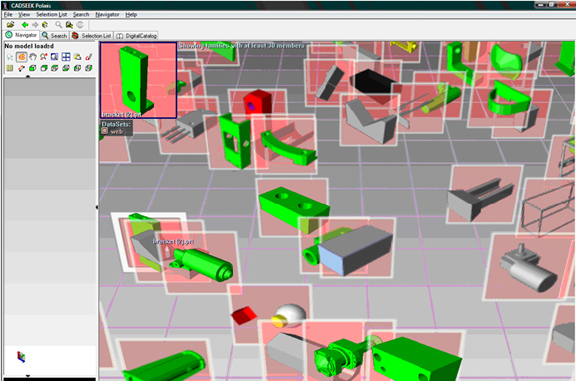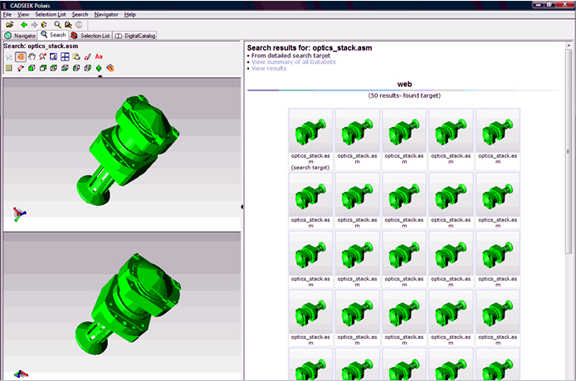Latest News
August 1, 2012
It’s easy to forget that the ubiquitous search box that has become such an integral part of how we find and locate information is a fairly recent phenomenon. It’s made possible by search engine providers’ preparatory efforts to scan, classify, and tag the vast body of knowledge we now have at our disposal. Without this service, it would take much more efforts on our end to locate what we need, buried somewhere between homegrown recipes to scientific papers on the origin of the universe.
Finding and locating a 3D part, however, requires a slightly different approach, because the information you seek is geometric, not easily described in text strings, keywords, and metadata. This is where emerging shape-based search technologies can give you an advantage. Shape-based search scan, find, and locate matching results based on geometry, not file names and tags; therefore, if the reference information is geometry, say, a unique type of bracket or a nonstandard hammerhead, you have a much greater chance of locating matching models in a given database with shape-based search. Otherwise, your search results will mostly likely be confined to items that are explicitly named or tagged bracket or hammerhead, and many of the items found probably won’t match your reference geometry.
A good example of a shape-based search technology is CADseek from iSeek. CADseek employs “fully automated shape coding” and “fully automated classification,” the company says. According to Abir Qamhiyah, president and CEO of iSeek, said, “[CADseek] doesn’t work by predefined classifications, rule-based hierarchy ... We don’t try to slice objects, we don’t send down [the reference geometry] as skeleton, and we certainly do not depend on extracted views or profiles to reduce the complexity of the geometry to the 2D domain. We take the full geometry content with its full richness, and feed it into our mathematical coding algorithm. The code becomes the exact correspondent of the true 3D content the shape owns.”
As with any search results, there’s an art to displaying matching results to the query. Google and other successful search engines does so by sophisticated algorithms that takes into account your past search history, the words and phrases you use to search, and display the results in order of relevance—the most likely answers at the top, the less relevant answers at the bottom.
CADseek takes a similar approach. Once you pick an item in the result-browser window, you get what the software considers “family members”—items with similar geometric features. The closest relatives are at the top of the list; the more distant cousins (those with greater topology differences to your reference geometry) are at the bottom.
Consider, for instance, the hypothetical case of two nearly identical engine blocks created by different designers who don’t know one another but work in the same company. With CADseek, you have the option to open up a 3D model as your reference, then search for matching shapes in your company database. In this example, even if the engineers were using different naming conventions and have a tendency to tag their works with different keywords when they deposit them into the company’s CAD library, the matching engine block will show up in CADseek’s search results based on topology similarity. Such a query will prevent unnecessary duplication of work and encourage people to reuse existing designs rather than create items from scratch.
Many PDM (product data management) and PLM (product lifecycle management) system providers recognize the importance of shape-based search. It’s a feature they’re actively working to incorporate into their technology, as an incentive for potential customers to adopt their products. Effective shape-based search must tackle two primary jobs: identifying topology similarities and displaying results in a comprehensible fashion. (The latter is important when the results contain not a few dozens but hundreds of hits, with minor differences in their geometry.) CADseek accomplishes both with ease and simplicity.
For more, watch the video demonstration below, created with iSeek’s help.
Subscribe to our FREE magazine, FREE email newsletters or both!
Latest News
About the Author
Kenneth Wong is Digital Engineering’s resident blogger and senior editor. Email him at [email protected] or share your thoughts on this article at digitaleng.news/facebook.
Follow DERelated Topics








